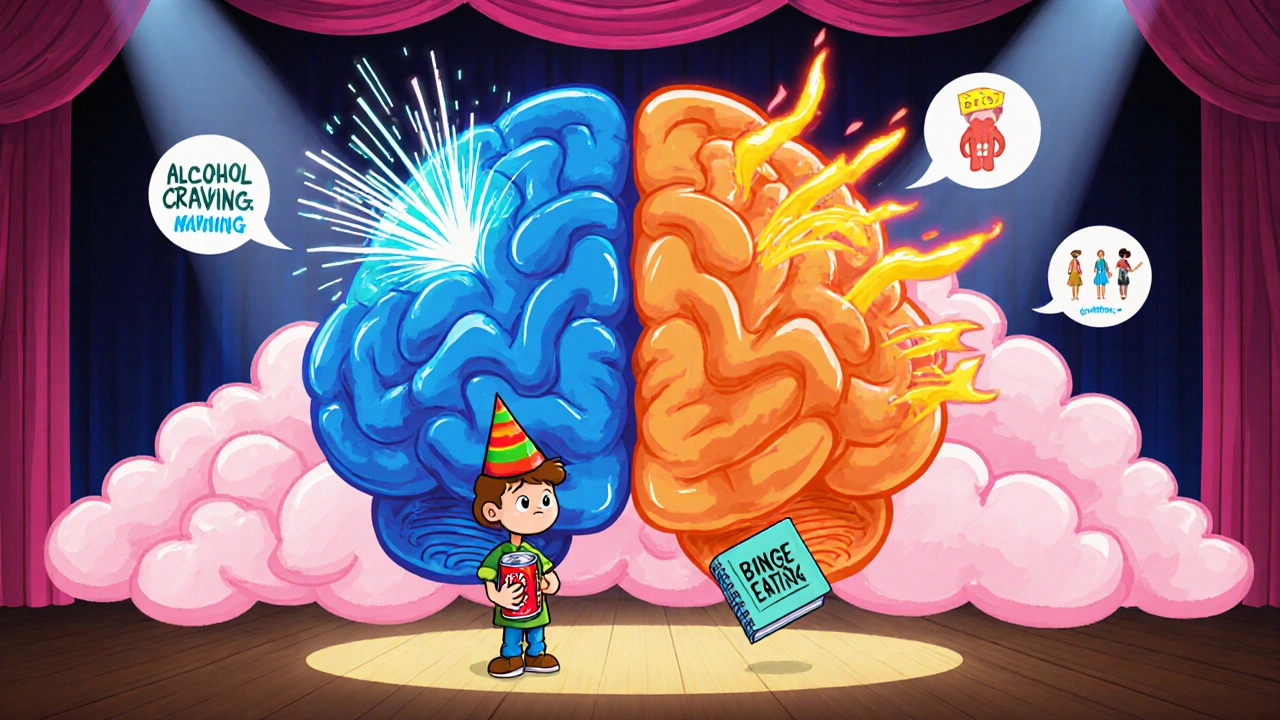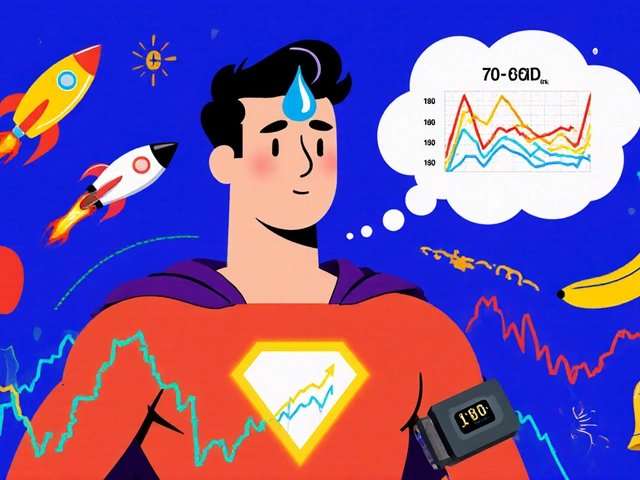Co-occurring Alcohol and Eating Disorder Risk Checker
This tool helps identify potential risk factors for co-occurring alcohol dependence and eating disorders. Please note: this is not a diagnostic tool, but rather a self-assessment based on clinical research. If you or someone you know is showing signs of these conditions, consult a healthcare professional immediately.
Alcohol-Related Indicators
Eating-Disorder Indicators
When you hear about Alcohol Dependence Syndrome is a chronic condition marked by an inability to control drinking despite harmful outcomes, you probably think of bars, hangovers, and liver damage. Eating Disorders is a group of serious mental health conditions that involve abnormal eating habits and preoccupation with body weight feels like a completely different arena-more about food, dieting, and body image. Yet, clinicians keep spotting patients who battle both at the same time. Understanding why these two seemingly opposite problems intertwine can save lives, cut treatment time, and help families catch warning signs early.
What is Alcohol Dependence Syndrome?
Alcohol Dependence Syndrome (ADS) is more than just drinking a lot. It includes three core features:
- Craving: an intense urge to drink.
- Loss of control: difficulty limiting intake.
- Physical dependence: withdrawal symptoms when alcohol is stopped.
ADS often co‑exists with other mental‑health issues such as Depression and Anxiety. The brain’s reward pathway, driven by dopamine and serotonin, becomes hijacked, making alcohol feel like the only way to feel normal.
What are Eating Disorders?
Eating disorders (EDs) come in several forms, each with distinct behaviors but shared underlying fear of weight gain and loss of control over food.
- Anorexia Nervosa: extreme restriction, intense fear of gaining weight, and often a distorted body image.
- Bulimia Nervosa: cycles of binge eating followed by compensatory actions like vomiting or excessive exercise.
- Binge Eating Disorder: recurrent episodes of eating large amounts of food without subsequent purging.
All three share high rates of perfectionism, low self‑esteem, and a tendency to use the disorder to regulate emotions.
Why Do They Co‑occur?
Researchers have identified several overlapping risk factors that turn ADS and EDs into a dangerous combo.
- Shared neurobiology: Both conditions involve the brain’s reward circuitry. Dopamine spikes from alcohol can mirror the pleasure‑boost from binge eating, reinforcing compulsive behavior.
- Emotional regulation: People who struggle to manage stress may turn to alcohol or disordered eating as coping mechanisms. Motivational Interviewing and Cognitive Behavioral Therapy both target these patterns.
- Genetic vulnerability: Family studies show that relatives of individuals with ADS are more likely to develop EDs, suggesting shared hereditary factors.
- Social pressures: Body‑image ideals and social drinking culture can intersect. For example, a teenager may binge‑drink at parties to fit in while secretly restricting food to meet a thin‑ideal.
- Co‑existing psychiatric disorders: Depression and anxiety often sit at the center, fueling both alcohol misuse and disordered eating.
These overlaps create a feedback loop: alcohol can suppress appetite, encouraging restrictive eating, while restrictive diets can trigger cravings for alcohol as a quick source of calories.

Spotting the Signs
Because ADS and EDs can mask each other, clinicians recommend a dual‑screening approach.
| Alcohol‑Related Indicator | Eating‑Disorder Indicator |
|---|---|
| Frequent blackouts or memory gaps | Rapid weight fluctuations |
| Drinking to hide emotional pain | Preoccupation with calories, portion control |
| Withdrawal symptoms (tremors, anxiety) | Episodes of secret binge eating |
| Neglect of responsibilities (work, school) | Excessive exercise or purging behaviors |
Notice how many of these cues overlap. If you see both sets in a patient, push for a thorough assessment.
Assessment and Diagnosis
Professional evaluation should involve:
- Standardized screening tools: AUDIT (Alcohol Use Disorders Identification Test) for alcohol, and EDE‑Q (Eating Disorder Examination Questionnaire) for eating habits.
- Medical labs: liver function tests, electrolyte panels, and hormonal profiles (e.g., cortisol) to gauge physiological impact.
- Psychiatric interview: explore mood, trauma history, and family patterns.
International Classification of Diseases (ICD‑11) lists ADS under "Alcohol Use Disorder" and EDs under "Feeding and Eating Disorders". Accurate coding helps insurance coverage and research tracking.

Integrated Treatment Strategies
Addressing both disorders simultaneously yields better outcomes than tackling them separately.
- Medical stabilization: If the patient is in acute withdrawal, administer Naltrexone or benzodiazepines under medical supervision. Treat electrolyte imbalances from purging or chronic drinking.
- Dual‑focus psychotherapy: A therapist trained in both Cognitive Behavioral Therapy (CBT‑E) and Motivational Interviewing can help patients re‑frame cravings and body‑image distortions.
- Family involvement: Family Therapy reduces blame cycles and supports a healthier home environment.
- Nutrition rehabilitation: A registered dietitian designs balanced meal plans that avoid trigger foods while restoring metabolic health.
- Peer support groups: 12‑step programs (e.g., AA) combined with ED peer groups (e.g., Overeaters Anonymous) provide community accountability.
Case studies from 2023‑2024 show that patients who completed a 12‑week integrated CBT‑E program reduced alcohol consumption by 45% and achieved a 30% remission rate for binge episodes.
Prevention and Early Intervention
Schools, workplaces, and primary‑care clinics can curb the rise of co‑occurring disorders by:
- Offering brief educational workshops on stress‑management rather than substance use.
- Implementing routine screening for both alcohol use and disordered eating during annual check‑ups.
- Promoting body‑positive media and responsible drinking campaigns.
- Training coaches and teachers to recognize warning signs before they become entrenched patterns.
Early talks about emotions, coping skills, and healthy relationships can break the cycle before it spirals.
Key Takeaways
Even though alcohol dependence and eating disorders look different on the surface, they share common brain pathways, emotional triggers, and genetic risks. Spotting both sets of symptoms, using dual‑screening tools, and applying an integrated treatment plan dramatically improve recovery odds. If you suspect someone is struggling with either condition, encourage a professional assessment-early help saves lives.
Can alcohol abuse cause an eating disorder?
Alcohol can suppress appetite and alter hormone levels, which may trigger restrictive eating or binge cycles. While alcohol alone rarely creates a full‑blown disorder, it can act as a catalyst, especially in people already vulnerable to body‑image concerns.
Do people with eating disorders drink more?
Research shows that individuals with bulimia or binge eating disorder often use alcohol as a way to cope with shame after binge episodes. Surveys from 2022 indicate up to 38% of women with bulimia report hazardous drinking patterns.
What is the best first‑step for treatment?
Stabilize any medical emergencies (withdrawal, electrolyte imbalance) then enroll in a dual‑focus therapy program that addresses both cravings and body‑image distortions simultaneously.
Are there medications that help both conditions?
Naltrexone reduces alcohol cravings and has shown modest benefit for reducing binge eating urges, likely by damping dopamine spikes. It should be prescribed only after a thorough medical review.
How long does recovery usually take?
Recovery timelines vary. A structured 12‑week program can bring significant reduction in symptoms, but many patients benefit from ongoing support for 6‑12 months to maintain gains and prevent relapse.





Scott Ring
October 23, 2025 AT 20:09Thanks for pulling together such a thorough overview. It really helps to see how the brain pathways overlap and why treating them together makes sense. The dual‑screening suggestion is spot on; catching both issues early can prevent a lot of complications down the line.
Tristram Torres
October 24, 2025 AT 12:00Honestly, this sounds like just another checklist for therapists to brag about. Most people never even think about linking booze to food issues until they’re already in deep trouble.
Jinny Shin
October 25, 2025 AT 03:16One cannot overlook the tragic poetry of a body torn between the seductive lure of alcohol and the relentless pursuit of an unattainable silhouette. The narrative is as old as modern medicine itself.
deepak tanwar
October 25, 2025 AT 04:40While the dramatization is appreciated, the data does not support the notion that alcohol is a primary driver of eating disorders. Correlation does not equal causation; many variables remain unaccounted for.
Abhishek Kumar
October 25, 2025 AT 15:46Sounds legit.
hema khatri
October 25, 2025 AT 17:10Great point!!! This really shows how our culture can push people to extremes-both in drinking and in dieting-so we need to stand united against harmful norms!!!
Heather ehlschide
October 26, 2025 AT 18:33From a clinical standpoint, incorporating the AUDIT and EDE‑Q in the same intake can streamline the process. Additionally, monitoring electrolyte levels early helps avoid dangerous complications when patients switch from alcohol to binge eating patterns.
Kajal Gupta
October 26, 2025 AT 19:56Absolutely! The blend of colorful meal plans and cognitive‑behavioral techniques can create a vibrant recovery journey. It's both creative and evidence‑based, striking a perfect balance.
Zachary Blackwell
October 26, 2025 AT 21:20First, let me say that the whole medical establishment is hiding the truth about how deeply the pharmaceutical industry is involved in treating both alcohol dependence and eating disorders. They push drugs like Naltrexone because they get sweet rebates, not because they're always the best choice. Second, the social engineering behind “dual‑focus psychotherapy” is really a way to keep patients in therapy longer, maximizing profit for clinics. Third, the data cited in the article often comes from industry‑funded studies that downplay side effects. Fourth, you’ll hear a lot about “family involvement,” but families are frequently used as scapegoats to shift blame away from systemic issues. Fifth, many of the “peer support groups” are run by organizations with hidden agendas, influencing participants subtly. Sixth, the genetics angle is overstated; environmental stressors play a larger role than we’re told. Seventh, the notion that alcohol suppresses appetite is used to scare teenagers, feeding a culture of fear. Eighth, the article glosses over the fact that many patients experience relapse because the underlying trauma isn’t addressed. Ninth, the proposed “routine screening” in primary care can turn doctors into gatekeepers for a lucrative market. Tenth, the idea that early education can prevent these disorders ignores socioeconomic disparities that limit access to resources. Eleventh, the claim that a 12‑week program works for everyone is unrealistic; recovery is highly individual. Twelfth, the article fails to mention that many patients develop dependence on the very medications prescribed to help them. Thirteenth, the emphasis on “body‑positive media” is a thin veneer for commercial campaigns that still profit from insecurities. Fourteenth, you’ll notice that the language used throughout is deliberately vague, avoiding accountability. Fifteenth, the bottom line is that we need to stay skeptical and demand transparent, independent research rather than accepting these polished narratives at face value.
Dan Danuts
November 1, 2025 AT 13:26Team, let’s keep the momentum going! Sharing these insights with local health workers can make a huge difference in early detection.
Dante Russello
November 1, 2025 AT 14:50Exactly! Providing quick reference cards with the key warning signs-like frequent blackouts paired with rapid weight changes-can empower non‑specialists to flag concerns early; this grassroots approach often catches issues before they spiral out of control.
James Gray
November 1, 2025 AT 16:13Love the energy here! I’m just gonna say – great job, everyone, keep spreading the word and don’t forget to check in on each other.
Shubhi Sahni
November 7, 2025 AT 08:20In summary, the intertwined nature of alcohol dependence and eating disorders calls for integrated screening, compassionate treatment, and community education. By adopting a holistic approach, we can improve outcomes and reduce stigma for those affected.